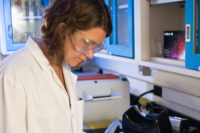E. coli O157:H7 – good testing practices
By Dennis R. Johnson
Question: When is testing for E. coli O157:H7 less desirable than not testing? Answer: When the testing does not provide reliable results. The Food Safety and Inspection Service does not mandate pathogen testing of raw products. That said, testing provides feedback to the system; whether the food-safety system is operating as intended. It would be very difficult, if not impossible, to show the system is working in absence of testing. If an establishment tests, the test results must be reliable.Otherwise, a plant may have a false sense of security — and in this case, what you do not know can and will hurt you.
Currently, there are no uniform testing practices. Until adoption, the following represents what could be considered basic “current good testing practices” or GTPs for E. coli O157:H7 testing of raw products.
These GTPs are based on learnings from the 17 outbreak recalls between 2007 and 2010. No establishment which used these GTPs and reacted to the results was implicated in any of these outbreaks. Establishments not following these GTPs were less fortunate. Beyond outbreaks, not following these GTPs have led to FSIS positive results/recalls and findings during Food Safety Assessments.
The GTPs address: sample selection, analytical sample size, laboratory method, and laboratory selection.
Sample selection
For trim intended for raw ground use, randomly select at least 60 pieces from each sub-lot of product. Excise surface tissue from each individual piece, selecting the side from the surface of the carcass, if present. If using a knife or scalpel, the dimensions should be 4 inches by 1/2 inch by 1/8 inch thick. The total sample weight should be in the range of 325-450 grams.
For ground beef, grab samples are taken (preference would be for at least 4 sub-samples) per sub-lot or day (if not sub-lotting). The total sample should weigh between 325-450 grams.
Analytical sample size
The analytical unit (the amount of product enriched and analyzed): for trim, 325-375 grams; for raw ground, 65 grams. Analyzing only a small (25-gram) sample was the No. 1 deviation from the GTPs in outbreak situations.
Laboratory method
For trim, most use a PCR-based or cultural method. Ground samples are analyzed using a lateral flow, PCR or cultural method.
Whatever method is chosen, be sure the method is validated for: (1) the organism being sampled, (2) the product being sampled (referred to as the matrix), and (3) the amount of product actually being analyzed (the analytical sample).
Laboratory selection
In selecting a laboratory, make sure the laboratory is certified both generally and for the test method being used. Also, make sure the laboratory participates in a proficiency program for the method and its last sets were satisfactory.
If you choose to test, make sure you are getting reliable results by following GTPs. Obviously, you need to react to the data as well, but that is a column for another day.
Dennis R. Johnson is a principal with Olsson Frank Weeda Terman Bode Matz PC in Washington, D.C. Mr. Johnson has 30 years experience in food-safety law and regulation, representing large and small meat and poultry companies and trade associations before USDA’s Food Safety and Inspection Service.
Question: When is testing for E. coli O157:H7 less desirable than not testing? Answer: When the testing does not provide reliable results. The Food Safety and Inspection Service does not mandate pathogen testing of raw products. That said, testing provides feedback to the system; whether the food-safety system is operating as intended. It would be very difficult, if not impossible, to show the system is working in absence of testing. If an establishment tests, the test results must be reliable.Otherwise, a plant may have a false sense of security — and in this case, what you do not know can and will hurt you.
Currently, there are no uniform testing practices. Until adoption, the following represents what could be considered basic “current good testing practices” or GTPs for E. coli O157:H7 testing of raw products.
These GTPs are based on learnings from the 17 outbreak recalls between 2007 and 2010. No establishment which used these GTPs and reacted to the results was implicated in any of these outbreaks. Establishments not following these GTPs were less fortunate. Beyond outbreaks, not following these GTPs have led to FSIS positive results/recalls and findings during Food Safety Assessments.
The GTPs address: sample selection, analytical sample size, laboratory method, and laboratory selection.
Sample selection
For trim intended for raw ground use, randomly select at least 60 pieces from each sub-lot of product. Excise surface tissue from each individual piece, selecting the side from the surface of the carcass, if present. If using a knife or scalpel, the dimensions should be 4 inches by 1/2 inch by 1/8 inch thick. The total sample weight should be in the range of 325-450 grams.
For ground beef, grab samples are taken (preference would be for at least 4 sub-samples) per sub-lot or day (if not sub-lotting). The total sample should weigh between 325-450 grams.
Analytical sample size
The analytical unit (the amount of product enriched and analyzed): for trim, 325-375 grams; for raw ground, 65 grams. Analyzing only a small (25-gram) sample was the No. 1 deviation from the GTPs in outbreak situations.
Laboratory method
For trim, most use a PCR-based or cultural method. Ground samples are analyzed using a lateral flow, PCR or cultural method.
Whatever method is chosen, be sure the method is validated for: (1) the organism being sampled, (2) the product being sampled (referred to as the matrix), and (3) the amount of product actually being analyzed (the analytical sample).
Laboratory selection
In selecting a laboratory, make sure the laboratory is certified both generally and for the test method being used. Also, make sure the laboratory participates in a proficiency program for the method and its last sets were satisfactory.
If you choose to test, make sure you are getting reliable results by following GTPs. Obviously, you need to react to the data as well, but that is a column for another day.
Dennis R. Johnson is a principal with Olsson Frank Weeda Terman Bode Matz PC in Washington, D.C. Mr. Johnson has 30 years experience in food-safety law and regulation, representing large and small meat and poultry companies and trade associations before USDA’s Food Safety and Inspection Service.
Looking for a reprint of this article?
From high-res PDFs to custom plaques, order your copy today!




